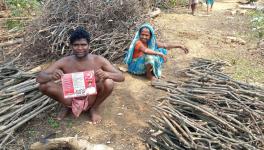Assam’s South-Western Districts have Abysmal Healthcare Services – I
The SDCH in Hatsingimari, South Salmara-Mankachar District.
The spread of COVID-19 across the world has a opened a Pandora's Box of some sort, as the healthcare system was found ill-equipped to deal with the exponential numbers of cases in most countries. In many countries, preventing the deaths appeared insurmountable. The pandemic posed a Himalayan challenge to the scientific community -- discovering the physiological basis of the disease severity, finding drugs or vaccines, etc.
Most of the scientific endeavours and some achievements have got global attention for their remarkable speed and efficiency. For example, vaccines were developed at an unprecedented pace in the history of medical science. Now, even when the pandemic is in no way going to disappear in a foreseeable time, frantic declarations about the success of a valiant fight against it has been surfacing everywhere.
However, these optics appear a case of jugglery if some cases are looked at thoroughly.
Let’s take the case of a tiny corner of the globe, the Southwestern part of the state of Assam in India’s Northeastern region.
Southwestern Assam comprises the districts of South Salmara-Mankachar, part of Dhubri and Goalpara. Consisting of widespread sand bars (Chars in local language) and riverine areas, this part of Assam has some of the most inaccessible places of the state and has one poorest road connectivity.
Some of the Chars have boats as the only means of communication. A significant portion of this region has almost nil health services, irrespective of the pandemic. It is worth mentioning that Assam has many such inaccessible sand bars, where similar abysmal health services can be expected.
South Salmara-Mankachar District
The Statistical Handbook of Assam -2020 has data of various state indicators, such as health. The district has only one Sub Divisional Civil Hospital (SDCH), no full-fledged Civil Hospital and 49 sub-centres. Interestingly, this data varies a bit when we look at the district administration’s website, which says that the number of sub-centres is 55 in the district.
However, the district administration’s website paints a grim picture when it says that the district has no chest hospital, no blood bank and blood storage unit along with two non-functional riverine PHC (Primary Health Centres). Notably, the district has a significant cluster of riverine areas.
The categories of government health structure could be understood from what a doctor explained to Newsclick in one of the hospitals. Requesting anonymity, he said: “A sub-centre is the lowest in the hierarchy of the health system and it caters around 5,000 people. The next level is the State Dispensary or PHCs, which cater to around 15,000-20,000 people. After that, there are Community Health Centers that provide service to 1-1.5 lakh people and then comes Civil Hospitals (district hospitals) or the SDCH (Sub Divisional Civil Hospitals).”
“The sub-centres actually don’t have doctors; they have nurses and other staff which provide some of the most preliminary health services and in cases of slightest complications, they refer to the nearest next higher level hospital”, he added. The civil hospitals are at the highest level in a district.
The only SDCH in the district is at Hatsingimari, the district headquarters and is situated near the DC office (Deputy Commissioner. Dr Samsul Haque, in-charge of the SDCH, spoke to NewsClick at length and explained the current status of the hospital and the measures taken during the peak of COVID-19 spread.
When asked about the availability of doctors and other health workers, Haque said the hospital had 14 doctors currently.
“But the number of nurses in our hospital is not sufficient. We currently have only 6-7 nurses. Moreover, there is also a shortage of paramedics and other staff, especially sweepers, which is essential for a hospital. We hire a few sweepers," he said. Notably, the only district hospital has to cater to a population of around 3.5-4 lakh.
The hospital also does not have an ICU facility, forget providing ventilation to serious patients.
“However, the hospital is being upgraded to a civil hospital, and it will have 12 ICU beds along with 12 pediatric ICUs,” he added.
NewsClick also visited the building of the ‘to be’ civil hospital which is under construction. Sariful Islam, the project manager, said they aim to complete construction this year.
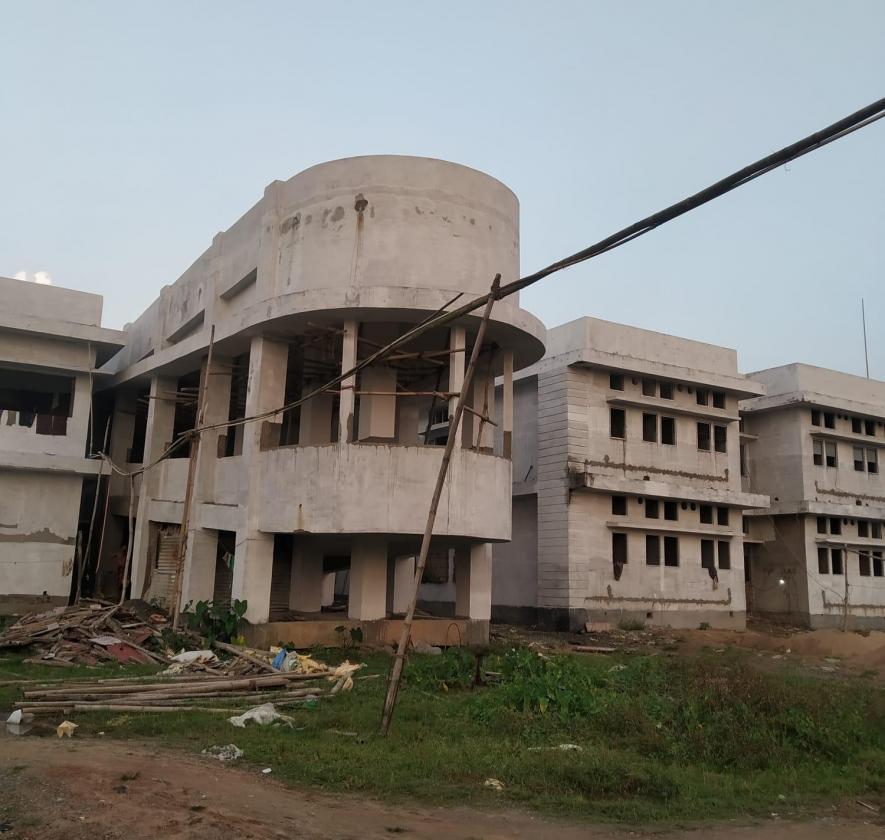
The ‘to be’ Civil Hospital in Hatsingimari besides the existing SDCH.
From the point of view of the district's citizens, the available health infrastructure and the services are not that impressive.
Soiful Islam, a resident of Charkacharipara village in Hatsingimari, told NewsClick: "Although there are many sub-centres, they cannot provide us with a prescription or a treatment, the maximum they can do is to offer primary dressings and basic medicines, and they readily refer us to the civil hospital. In the civil hospital also, we don't have specialists that can provide us treatment in chronic and severe diseases; we don't have eye specialists, cardiologists, etc."
What Islam said was corroborated by other villagers. Saleh Ashaud, from another village near Fulbari, a bit far from Hatsingimari, expressed his grief and anger.
"Our village is an interior one on the bank of the river. The roads are in abysmal condition, just like hospital facilities. Taking a patient who needs an emergency service becomes a huge problem for us, as we don't have available ambulance services. It's only the villagers whose cooperation has saved some lives in the past," Ashaud said.
Rinku, a young boy from Gazarikandi, recounted how far they had to travel and how painful it is to get decent treatment.
"Many of us here depend on the hospitals in Goalpara district, that too in the private sector, which sometimes are costly. This limits the health facilities to affluent people. Otherwise, we need to travel to Guwahati, which is around 250 kilometres from here," he said.
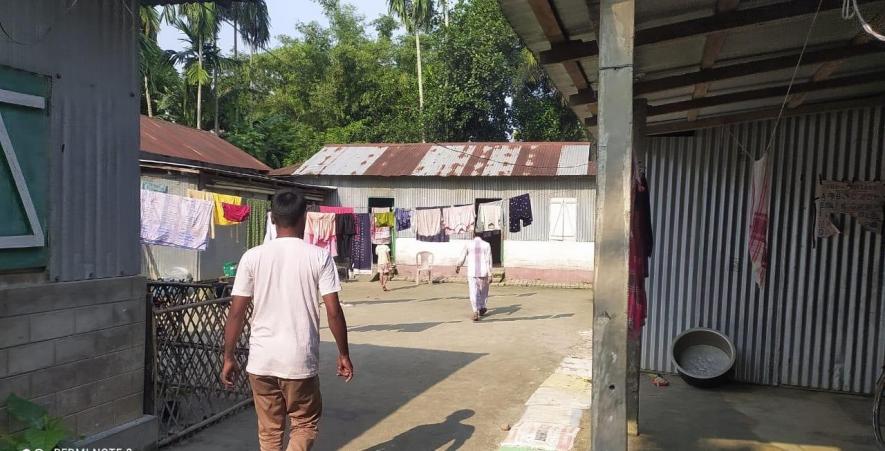
Village households, where the houses are made of tins instead of bricks. The tinned houses are dismantled when flood ravages.
Travelling to Guwahati from Mankachar or Hatsingimari is not an easy ride. The direct road from Hatsingimari to Guwahati via Goalpara is in pathetic condition, which we also experienced. From Hatsingimari to Goalpara, one needs to travel via Chibinang, Tikrikilla, in the Assam-Meghalaya border. The entire stretch is a bumpy one.
In some locations, there is virtually no pitched road. "This road, lying at the Assam-Meghalaya border, is of no interest for both Assam and Meghalaya governments, and we have to bear the brunt of it. The NEC (North East Council) constructed the pitched road some years back," Rinku explained.
The other road, in good condition, goes up the hills to Tura (Meghalaya) from Mankachar and climbs down to Goalpara.
Interestingly, the government health sector is limited in its space and capacity, and the entire district has a minuscule number of private hospitals. Even in the main centre of Hatsingimari, not a single private hospital or big clinic could be spotted. The number of pharmacies were also quite dismaying.
With this status quo of the health infrastructure, one wonders how the pandemic was fought here?
Haque gave some account of the measures taken to contain COVID-19, of the availability of medicines, beds, oxygen and food supply.
"We did not face a scarcity of oxygen during both first and the second waves of COVID-19. We used to purchase it from Bongaigaon before our oxygen cylinders went dry. Some of the expenses were borne by the district administration, which was helpful throughout the period," he said.
Haque said: "Medicines like remdesivir, imeglibin, piperacillin were available with us. But as the hospital does not have an ICU, we had to refer the severe patients to Guwahati, Barpeta or Goalpara; however, Guwahati was the best choice for us. The district administration lent us a helping hand when we needed extra ambulances."
Asked whether the number of beds and other facilities was increased, he said: "We had 34/35 beds available for the COVID-19 patients. An oxygen plant was also installed in the hospital, but it is not fully functional yet. We also created an isolation centre for the COVID-19 patients in the Kanaimari PHC."
The government of Assam created makeshift hospitals dedicated to COVID-19 patients in Guwahati. Those were among the government's focusing points for advertising itself. However, that kind of initiative could not be visible in the remote district of South Salmara-Mankachar.
The ADC (Additional Deputy Commissioner) of the district, while speaking to NewsClick, also agreed that there is a need to improve health infrastructure in the district.
"There are several remote riverine areas in the district, where reaching health services is quite a tough affair. We need more infrastructure," he said.
Low Vaccination Drive and How It Was Overcome
The South Salmara-Mankachar district was the lowest vaccinated one in India. Till June, the district had a vaccination rate of 3.2 doses per 100 people. However, the district has seen some improvements now.
The district administration, health workers, local leaders and influential personalities, and wide-scale campaigning could give some success in elevating the vaccination rate.
Dr Md. Sirajul Islam, the DIO (District Immunisation Officer), spoke to Newsclick detailing the measures taken, “The initial widespread vaccine hesitancy was due to large-scale circulation of rumours and superstitious messages through social media, especially Whatsapp. The people were frightened unnecessarily, and nobody was eager to take the vaccine. We faced lots of difficulties.”
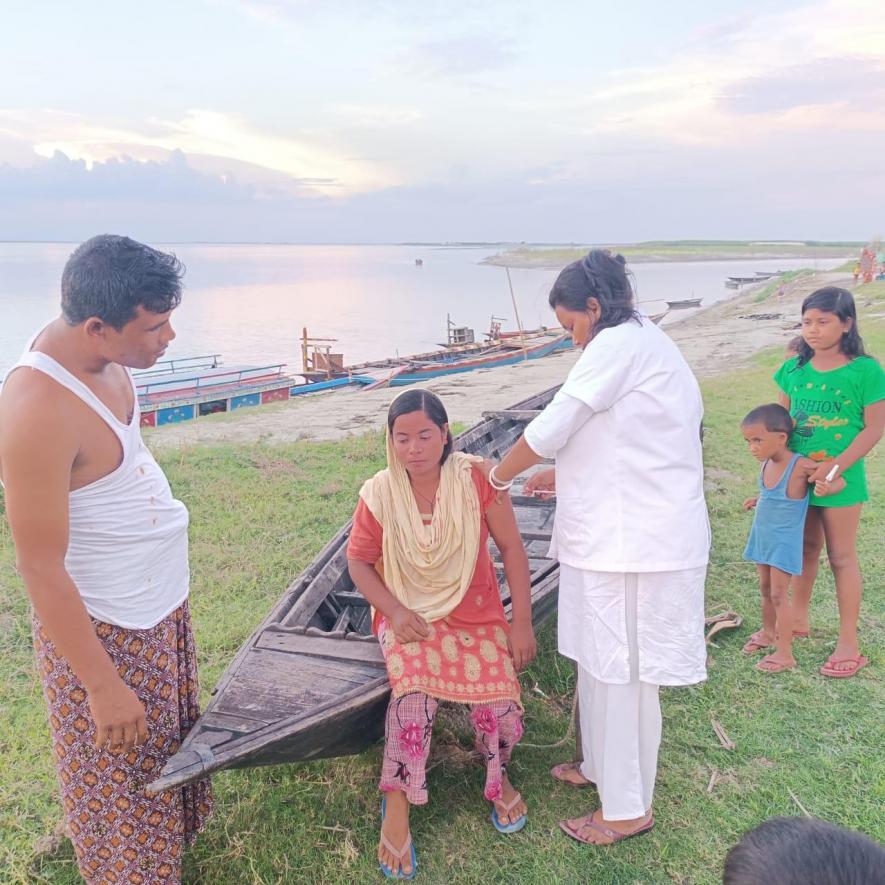
Vaccination drive in sandbars. Photo credit: Sirajul Islam.
“Then the district administration and health workers joined hands to take up the challenge. We engaged influential personalities of the area, teachers, NGOs in the process. We all reached out to the people and tried to convince them that the vaccine will not harm them. In some places, the aged and influential people took the vaccine dose in front of the villagers. We had to organise meetings for the occasion. Gradually and painstakingly, we could increase the vaccination drive, which is at a steady pace now.”
The ADC echoed similar sentiments. “We had to involve all the stakeholders of the society combined with mass campaigning to reach some reasonable rate of vaccination. In the remotest riverine areas and sandbars, health workers were sent in boats and conducted the vaccination. Without the massive support of all sorts of health workers—the ASHA workers, ANM nurses, GNM workers- and the local leaders and people, it would not have been possible,” he said.
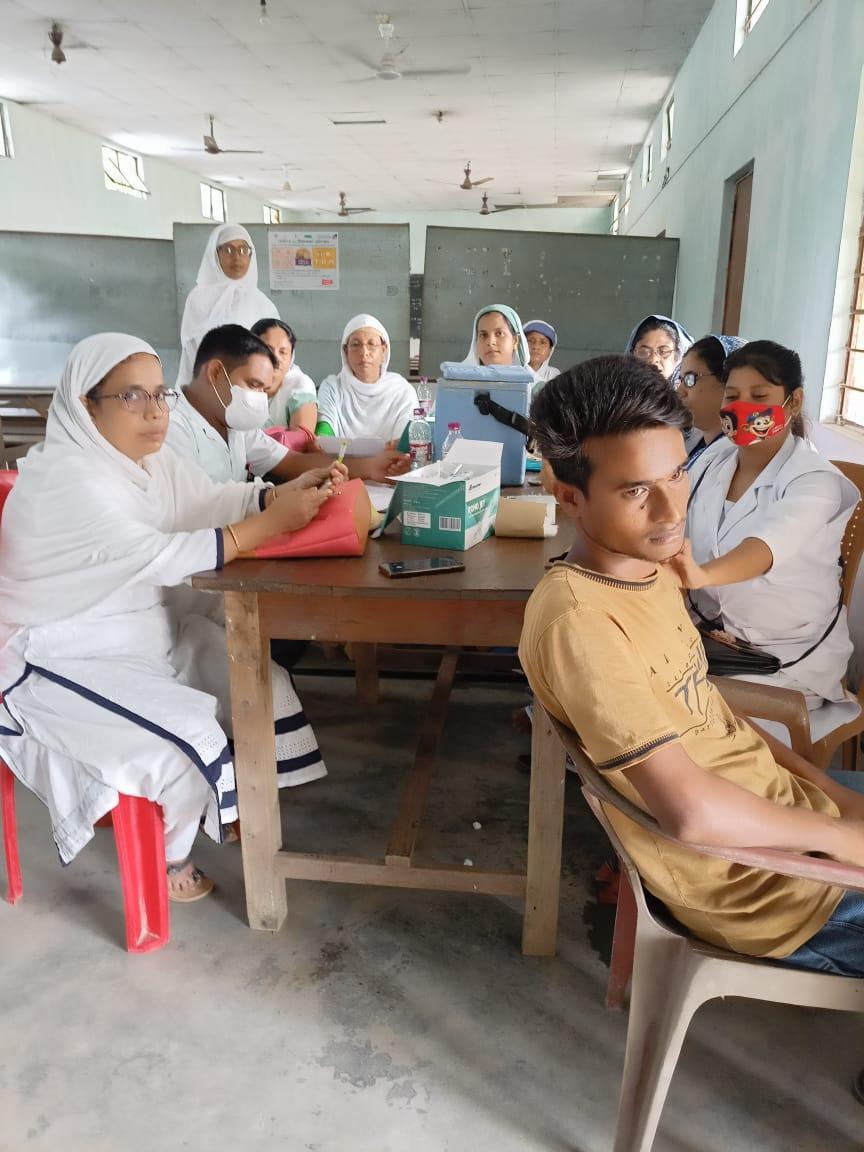
A vaccination centre in South Salmara-Mankachar. Photo credit: Sirajul Islam
Yes, the remote and inaccessible district bordering Bangladesh needs improved health infrastructure, but that alone is not enough. The people there, mainly migrant workers who live in constant fear of losing their land in flood and erosions, need development policies of all sorts, be it education, better livelihood, social status or electricity.
Read Part 2 here.
The reporter’s research was supported by a grant from Thakur Family Foundation. Thakur Family Foundation has not exercised any editorial control over the contents of this research.
Get the latest reports & analysis with people's perspective on Protests, movements & deep analytical videos, discussions of the current affairs in your Telegram app. Subscribe to NewsClick's Telegram channel & get Real-Time updates on stories, as they get published on our website.


















